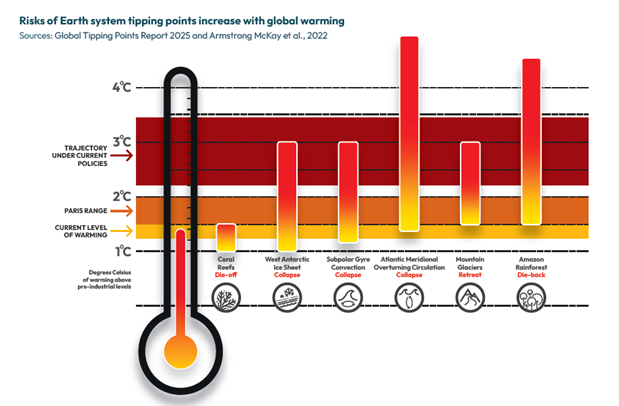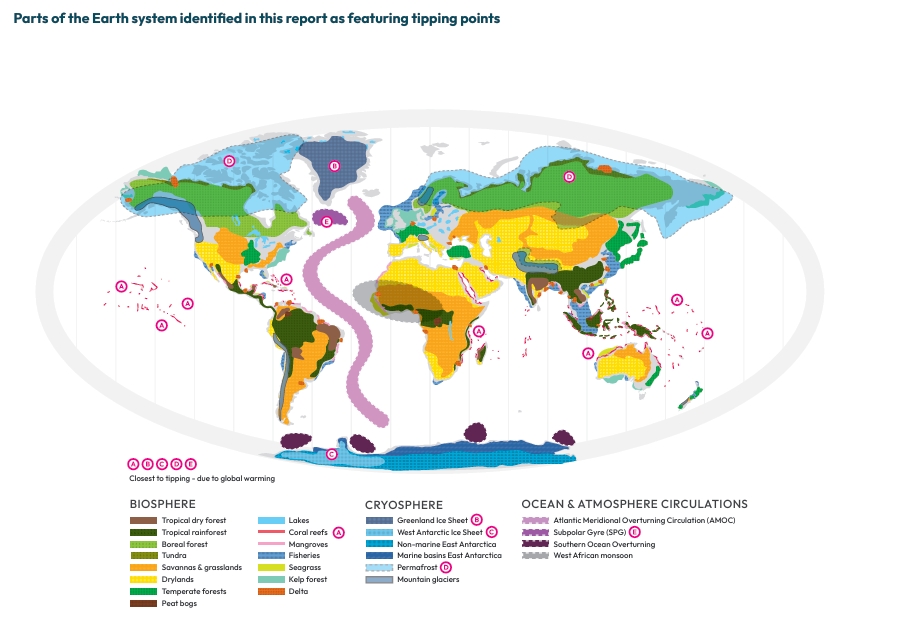Tipping, tipping, tipping... the dominoes fall
October 19, 2025
Dying reefs, shrinking icesheets, withering forests and collapsing currents are the latest symptoms of an Earth system enduring dangerous trauma, according to the Global Tipping Points Report 2025.
Compiled by 160 earth scientists led by Exeter University and the Potsdam Institute for Climate Impact Research, the report provides a spine-chilling update on the unconstrained human havoc at work on Planet Earth.
From glacial outbursts in Alaska, to dying coral reefs in the tropics, to tree die-back in the Amazon and the imminent collapse of the North Atlantic circulation, humans are soon to cross into an uncharted world of devastating shocks and consequences.
A tipping point is a moment in time in a system when a small influence or trend results in sudden, catastrophic or irreversible change. It is, in effect, a “point of no return”, when everything changes.
“We have more and more evidence for tipping points in all these different systems,” warns PIK scientist Sina Loriani. “There is an increasing risk that we kick off feedback loops that amplify and accelerate changes in the Earth system.”
The researchers caution that abrupt and irreversible Earth system tipping points pose a different type of threat to previous environmental challenges – and that current policies and decision-making by governments are not adequate to prevent them.
Further, the risk of tipping points becoming dramatically worse in impact increases with every fraction of a degree of global heating. At 1.5 degrees C, the big impacts start to kick in.

“The world has entered a new reality. Global warming will soon exceed 1.5°C. This puts humanity in the danger zone where multiple climate tipping points pose catastrophic risks to billions of people,” the report states.
“Already warm-water coral reefs are crossing their thermal tipping point and experiencing unprecedented dieback, threatening the livelihoods of hundreds of millions who depend on them.
“Polar ice sheets are approaching tipping points, committing the world to several metres of irreversible sea-level rise that will affect hundreds of millions.
“Every fraction of additional warming increases the risk of triggering further damaging tipping points. These include a collapse of the Atlantic Meridional Overturning Circulation that would radically undermine global food and water security and plunge northwest Europe into prolonged severe winters.
“Together, climate change and deforestation put the Amazon rainforest at risk of widespread dieback below 2°C global warming, threatening incalculable damage to biodiversity and impacting more than 100 million people who depend on the forest."
Climate tipping point risks are interconnected and most of the interactions between them are destabilising, meaning tipping one system makes tipping another more likely, the report warns.

Figure 1. The various tipping points identified by world climate science. Despite their relative remoteness, they still have capacity to harm the daily lives of hundreds of millions of people.
The burden of the message in the latest report is that humans cannot afford to let the Earth become even 0.1 of a degree hotter. We are already at 1.5 degrees and any increase will trigger unaccountable events that will generate profound threats to food security, energy infrastructure, economic stability and social cohesion, affecting billions globally.
To prevent any further increase, “global carbon emissions must be halved by 2030”, the report states.
Clearly, powers such as the US, Russian, Saudi, Chinese, Australian and Indian Governments are implacably opposed to such a target – indeed, several are energetically ramping up their carbon output, hastening the deaths of millions.
Towards the end, the report adopts a brittle optimism “Every tipping point of danger can be mirrored by a tipping point of opportunity. If coral reefs are dying back, restoration of coastal ecosystems can still drive resilience and livelihoods. If forests are at risk, their regeneration can unlock carbon removal, biodiversity recovery, and sustainable prosperity. If energy systems remain carbon-intensive, the exponential uptake of renewables and electrification can define a new, development model that cascades into positive change across other sectors.”
Nowhere, however, do humanity’s current collective actions, or those of its governments, come close to achieving the sought-for stability, opportunity or resilience. Instead, they mostly add momentum to the process of collapse. That the scientists know this is revealed by all the “ifs”.
Indeed, many of the “solutions” which the report posits appear more intended to appease powerful interests such as capital markets, the AI sector and the supremely unapologetic fossil fuels industry than actually solve the problem.
The assumption that status quo systems like capital and energy can be easily reconfigured to save humanity appears one of the report’s weakest foundations. Even the assumption that humans could repair half the world’s forests is questionable.
The warning from science is stark – and this report makes no bones about that. However, its obsequious attempts not to provoke the enemies of a human future does nothing more than give comfort to the worst of human behaviour, and the catastrophes it inevitably brings.
The views expressed in this article may or may not reflect those of Pearls and Irritations.
